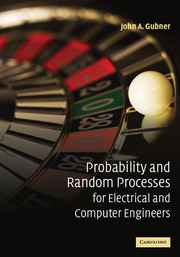Book contents
- Frontmatter
- Contents
- Chapter dependencies
- Preface
- 1 Introduction to probability
- 2 Introduction to discrete random variables
- 3 More about discrete random variables
- 4 Continuous random variables
- 5 Cumulative distribution functions and their applications
- 6 Statistics
- 7 Bivariate random variables
- 8 Introduction to random vectors
- 9 Gaussian random vectors
- 10 Introduction to random processes
- 11 Advanced concepts in random processes
- 12 Introduction to Markov chains
- 13 Mean convergence and applications
- 14 Other modes of convergence
- 15 Self similarity and long-range dependence
- Bibliography
- Index
15 - Self similarity and long-range dependence
Published online by Cambridge University Press: 05 June 2012
- Frontmatter
- Contents
- Chapter dependencies
- Preface
- 1 Introduction to probability
- 2 Introduction to discrete random variables
- 3 More about discrete random variables
- 4 Continuous random variables
- 5 Cumulative distribution functions and their applications
- 6 Statistics
- 7 Bivariate random variables
- 8 Introduction to random vectors
- 9 Gaussian random vectors
- 10 Introduction to random processes
- 11 Advanced concepts in random processes
- 12 Introduction to Markov chains
- 13 Mean convergence and applications
- 14 Other modes of convergence
- 15 Self similarity and long-range dependence
- Bibliography
- Index
Summary
Prior to the 1990s, network analysis and design was carried out using long-established Markovian models such as the Poisson process. As self similarity was observed in the traffic of local-area networks, wide-area networks, and in World Wide Web traffic, a great research effort began to examine the impact of self similarity on network analysis and design. This research has yielded some surprising insights into questions about buffer size versus bandwidth, multiple-time-scale congestion control, connection duration prediction, and other issues.
The purpose of this chapter is to introduce the notion of self similarity and related concepts so that the student can be conversant with the kinds of stochastic processes being used to model network traffic. For more information, the student may consult the text by Beran, which includes numerous physical models and a historical overview of self similarity and long-range dependence.
Section 15.1 introduces the Hurst parameter and the notion of distributional self similarity for continuous-time processes. The concept of stationary increments is also presented. As an example of such processes, fractional Brownian motion is developed using the Wiener integral. In Section 15.2, we show that if one samples the increments of a continuous-time self-similar process with stationary increments, then the samples have a covariance function with a specific formula. It is shown that this formula is equivalent to specifying the variance of the sample mean for all values of n.
- Type
- Chapter
- Information
- Publisher: Cambridge University PressPrint publication year: 2006
- 1
- Cited by

